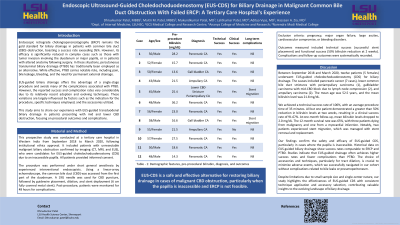Tuesday Poster Session
Category: Interventional Endoscopy
P4496 - Endoscopic Ultrasound-Guided Choledochoduodenostomy (EUS-CDS) for Biliary Drainage in Malignant Common Bile Duct Obstruction With Failed ERCP: A Tertiary Care Hospital's Experience
Tuesday, October 29, 2024
10:30 AM - 4:00 PM ET
Location: Exhibit Hall E

Has Audio

Dhruvkumar Patel, MBBS
LSU Health Science Center
Shreveport, LA
Presenting Author(s)
Dhruvkumar Patel, MBBS1, Maitri M. Patel, MBBS2, Mukundkumar Patel, MD3, Lalitkumar Patel, MD4, Aditya Vyas, MD5, Hassaan A. Zia, MD5
1LSU Health Science Center, Shreveport, LA; 2GCS Medical College and Research Centre, Ahmedabad, Gujarat, India; 3Ananya College of Medicine and Research, Ahmedabad, Gujarat, India; 4Narendra Modi Medical College, Ahmedabad, Gujarat, India; 5LSU Health, Shreveport, LA
Introduction: Endoscopic retrograde cholangiopancreatography (ERCP) is the established procedure for managing biliary drainage in patients with common bile duct obstruction, with a success rate exceeding 95%. However, its applicability diminishes in cases involving tumor invasion of the duodenum or major papilla, as well as in post-surgical scenarios. This study investigates the outcomes of endoscopic ultrasound (EUS)-guided choledochoduodenostomy as an alternative approach for patients with unsuccessful ERCP in cases of malignant mid and lower-end biliary obstruction with an unreachable papilla.
Methods: Conducted as a single-center prospective observational study, this research compiled data from patients undergoing choledochoduodenostomy confirmed malignancy with mid and lower-end common bile duct (CBD) block between September 2018 and March 2020. Exclusion criteria encompassed pregnancy, major organ failure, large volume ascites, compromised cardiovascular status, and bleeding disorders. The study assessed technical success, defined as successful stent placement in the biliary system, and successful clinical outcomes, defined as more than 50% reduction in bilirubin on the 14th day. Procedure and follow-up complications were also documented.
Results: EUS-guided choledochoduodenostomy was performed on 12 patients. The causes of biliary obstruction varied: seven cases were attributed to pancreatic cancer, one to lower CBD strictures with periampullary carcinoma, two to gallbladder carcinoma with mid-CBD block due to compression by metastatic lymph nodes, and two to ampullary carcinoma. The mean bilirubin value was 21.8 mg/dL (±3.4 mg/dL). The study demonstrated a 100% technical success rate and a 91.67% clinical success rate. No immediate procedure-related complications were observed, although two patients experienced stent migration during follow-up. Following an average follow-up period of 12 months (±2 months), the survival rate was recorded at 65%. Among the four patients who did not survive, three succumbed to the underlying malignancy, while one experienced a massive anterior wall myocardial infarction.
Discussion: EUS-guided choledochoduodenostomy is proving to be a safe and effective alternative for restoring biliary drainage in cases of mid and lower-end malignant CBD obstruction, particularly when the papilla is inaccessible and ERCP is not feasible.
Note: The table for this abstract can be viewed in the ePoster Gallery section of the ACG 2024 ePoster Site or in The American Journal of Gastroenterology's abstract supplement issue, both of which will be available starting October 27, 2024.
Disclosures:
Dhruvkumar Patel, MBBS1, Maitri M. Patel, MBBS2, Mukundkumar Patel, MD3, Lalitkumar Patel, MD4, Aditya Vyas, MD5, Hassaan A. Zia, MD5. P4496 - Endoscopic Ultrasound-Guided Choledochoduodenostomy (EUS-CDS) for Biliary Drainage in Malignant Common Bile Duct Obstruction With Failed ERCP: A Tertiary Care Hospital's Experience, ACG 2024 Annual Scientific Meeting Abstracts. Philadelphia, PA: American College of Gastroenterology.
1LSU Health Science Center, Shreveport, LA; 2GCS Medical College and Research Centre, Ahmedabad, Gujarat, India; 3Ananya College of Medicine and Research, Ahmedabad, Gujarat, India; 4Narendra Modi Medical College, Ahmedabad, Gujarat, India; 5LSU Health, Shreveport, LA
Introduction: Endoscopic retrograde cholangiopancreatography (ERCP) is the established procedure for managing biliary drainage in patients with common bile duct obstruction, with a success rate exceeding 95%. However, its applicability diminishes in cases involving tumor invasion of the duodenum or major papilla, as well as in post-surgical scenarios. This study investigates the outcomes of endoscopic ultrasound (EUS)-guided choledochoduodenostomy as an alternative approach for patients with unsuccessful ERCP in cases of malignant mid and lower-end biliary obstruction with an unreachable papilla.
Methods: Conducted as a single-center prospective observational study, this research compiled data from patients undergoing choledochoduodenostomy confirmed malignancy with mid and lower-end common bile duct (CBD) block between September 2018 and March 2020. Exclusion criteria encompassed pregnancy, major organ failure, large volume ascites, compromised cardiovascular status, and bleeding disorders. The study assessed technical success, defined as successful stent placement in the biliary system, and successful clinical outcomes, defined as more than 50% reduction in bilirubin on the 14th day. Procedure and follow-up complications were also documented.
Results: EUS-guided choledochoduodenostomy was performed on 12 patients. The causes of biliary obstruction varied: seven cases were attributed to pancreatic cancer, one to lower CBD strictures with periampullary carcinoma, two to gallbladder carcinoma with mid-CBD block due to compression by metastatic lymph nodes, and two to ampullary carcinoma. The mean bilirubin value was 21.8 mg/dL (±3.4 mg/dL). The study demonstrated a 100% technical success rate and a 91.67% clinical success rate. No immediate procedure-related complications were observed, although two patients experienced stent migration during follow-up. Following an average follow-up period of 12 months (±2 months), the survival rate was recorded at 65%. Among the four patients who did not survive, three succumbed to the underlying malignancy, while one experienced a massive anterior wall myocardial infarction.
Discussion: EUS-guided choledochoduodenostomy is proving to be a safe and effective alternative for restoring biliary drainage in cases of mid and lower-end malignant CBD obstruction, particularly when the papilla is inaccessible and ERCP is not feasible.
Note: The table for this abstract can be viewed in the ePoster Gallery section of the ACG 2024 ePoster Site or in The American Journal of Gastroenterology's abstract supplement issue, both of which will be available starting October 27, 2024.
Disclosures:
Dhruvkumar Patel indicated no relevant financial relationships.
Maitri Patel indicated no relevant financial relationships.
Mukundkumar Patel indicated no relevant financial relationships.
Lalitkumar Patel indicated no relevant financial relationships.
Aditya Vyas indicated no relevant financial relationships.
Hassaan A. Zia indicated no relevant financial relationships.
Dhruvkumar Patel, MBBS1, Maitri M. Patel, MBBS2, Mukundkumar Patel, MD3, Lalitkumar Patel, MD4, Aditya Vyas, MD5, Hassaan A. Zia, MD5. P4496 - Endoscopic Ultrasound-Guided Choledochoduodenostomy (EUS-CDS) for Biliary Drainage in Malignant Common Bile Duct Obstruction With Failed ERCP: A Tertiary Care Hospital's Experience, ACG 2024 Annual Scientific Meeting Abstracts. Philadelphia, PA: American College of Gastroenterology.
